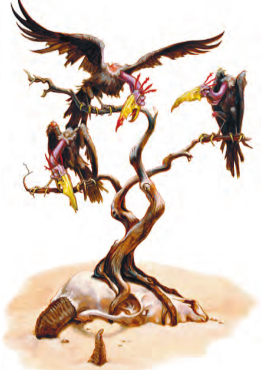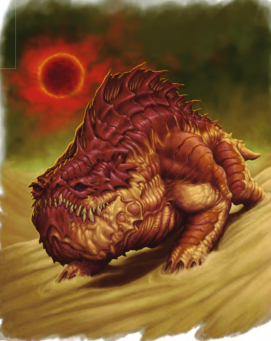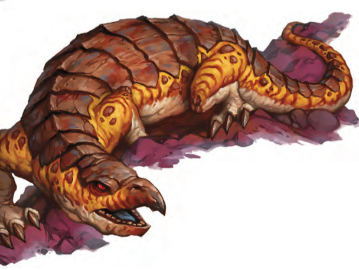Posts
-
Let's Read the 4e Dark Sun Creature Catalog: Kestrekel

A flock of kestrekels, who look like vultures with oversized serrated beaks. Copyright 2010 Wizards of the Coast. This post is part of a series! Click here to see the rest.
The Lore
Kestrekels are not to be confused with kestrels, which might not even exist in Athas. They’re basically Darker and Sunnier vultures, with a habit of gathering around creatures that are about to die in the wastes. They’re a lot more enthusiastic about hurrying the process along than their mundane counterpart, and while a single kestrekel isn’t much of a threat a whole flock of them can be very dangerous.
Those who want to turn the tables and hunt the birds instead might be able to draw them closer by feigning injury, but this rarely works - they’re a bit too clever for that tactic.
The Numbers
Kestrekels are Tiny Natural Beasts with a ground speed of 2 and a flight speed of 6. We get two stat blocks here.
Kestrekel Carrion Eater
This one represents a single individual. It’s drawn to movement, so even a traveller who isn’t wounded or dying might find one or three of these staring at them from a distance, and following them for a while.
The kestrekel is a Level 1 Minion Skirmisher. Its claw attack is stronger against bloodied targets, and its Darting Rake at-will ability lets it shift 3 squares and make a claw attack.
Kestrekel Blood Flock
You might get a whole flock like this one on battlefields and similar places, where carrion abounds and its smell carries great distances. This is a Medium swarm of kestrekels, counting as a Level 2 Controller with 35 HP.
The flock has all standard swarm traits: half damage from melee and ranged attacks, vulnerable 5 to close and area attacks, can occupy enemy spaces, can squeeze past any opening large enough for a Tiny creature.
Its Swarm Attack aura (1) deals a bit of physical damage to enemies caught inside, and also slows them for a turn when that happens. Its basic attack is a swarm of Scrabbling Claws, which does standard physical damage with a small bonus against bloodied targets.
The flock’s sheer bloodlust is also a weapon: the Loathsome Feast ability is a psychic attack that can be used if the flock is adjacent to a bloodied enemy. It attacks enemy Will in a close burst 3, deals psychic damage, and pushes each target hit a number of squares equal to their speed.
Encounters and Final Impressions
Whether you’re dealing with a few individuals or a whole flock, kestrekels are very opportunistic. They’ll stay away and watch until they see their victim is injured, sick, or dying. Then they dive in. Spilled blood also drives them into a frenzy, so they’re sure to join in on any fight that they see starting, intent on eating the combatants.
These things don’t exactly spark joy in me, but it feels like they’re an interesting addition to any battlefield, where they’d be a constant hazard.
-
Let's Read the 4e Dark Sun Creature Catalog: Kank

A jhakar, a stocky dog-lizard hybrid with a pug-like face. Copyright 2010 Wizards of the Coast. This post is part of a series! Click here to see the rest.
The Lore
Kanks are giant, beetle-like hive insects. A wild hive will viciously attack strangers and intruders, but they’re actually relatively easy to domesticate: just start feeding them. After a while, the kanks will start seeing those who bring them food as members of the hive.
Each hive has a queen that does little more than continuously lay eggs. The larvae that hatch from these eggs can specialize in one of two ways:
Kank spitters are the hive’s workers. Their duty is to forage for any sort of organic matter and process it into a nutritive nectar that is used to feed the hive (and extracted to feed people). They can store the noxious byproducts of this processing and spit them at intruders as a form of defense, hence their name.
Kank soldiers are very straightforward: they’re big, they’re strong, they have huge mandibles. Their duty is to protect spitters from threats. When properly trained, they’re also extremely popular war mounts.
The Numbers
Kank queens are too immobile to get combat stats, but we do get stats for the other two types. Both are Natural Beasts with a ground speed of 8 and Resist 5 Acid and Poison.
Kank Spitter
Spitters are Small but not defenseless. They’re Level 2 Artillery with 30 HP. Their bites do a mix of untyped and acid damage. Their Kank Spit has range 10. On a hit it does a little bit of physical damage, inflicts ongoing 5 acid damage, and slows (save ends). If the target was already slowed, it is immobilized instead.
Kank Soldier
These Large kanks are Level 4 Soldiers with 54 HP and the Mount tag. Their bite is rather weak to start with, but it grabs on a hit. Once the soldier has a grabbed victim, it can only bite that victim, but its bite attack gains +2 to attack and +10 to damage.
The soldier can instead choose to inject the victim with Kank Venom (recharge 5+), an attack that targets Fortitude, slows, and deals ongoing 10 poison damage (save ends both). After the first saved throw, this worsens to immobilized.
If serving as a mount, their benefit is Grabbed Advantage: this gives their rider combat advantage against the kank’s grabbed victim.
Kank soldiers don’t have marking mechanics, but they don’t need them. They’ll focus on a victim and try to keep it grabbed by their mandibles, using the venom as a parting shot if they have reason to release the grab.
Encounters and Final Impressions
I keep hearing about kanks in other Dark Sun Let’s Reads, so it’s nice to finally put a (bug) face to the name, so to speak. They feel more interesting to me than crodlus, both because they’re beetles and because they have a use other than “war mount” to their humanoid caretakers.
-
Let's Read the 4e Dark Sun Creature Catalog: Jhakar

A jhakar, a stocky dog-lizard hybrid with a pug-like face. Copyright 2010 Wizards of the Coast. This post is part of a series! Click here to see the rest.
The Lore
Described as “small, squat, and pugnacious”, these round boys are reptilian dog equivalents with keen senses and a vicious streak. On the wild they follow your standard pack hunter structure, but they’re also frequently “tamed” by people for use as combat, guard, and tracker animals.
“Tamed” is in quotes here because jhakars don’t form bonds of loyalty with their handlers. They respect strength and pain, but they also nurse grudges. So the process of training a jhakar is quite cruel and results in a creature that’s likely to turn on their handler as soon as it sees a chance. Ironically, because of this owning a trained jhakar is seen as a sign of strength.
The Numbers
Jhakars are Small Natural Beasts with the Reptile tag. They have a ground speed of 6 and Low-Light Vision. Their signature ability is Uncanny Senses, which makes their attacks ignore concealment.
Jhakars don’t have supernatural tracking abilities like some of the monsters we saw before, but you can probably consider them as good at it as a trained mundane hound.
Jhakar Tracker
This specimen is a Level 1 Skirmisher with 28 HP and all standard jhakar traits. As mentioned above, it’s probably as good at tracking as a mundane dog, but its stat block focuses more on what it does once it finds its prey.
The tracker’s bite does standard damage with a sizable bonus against targets granting combat advantage to it. The attack also lets the tracker shift 1 square as an effect.
Once per encounter the tracker can use an Opportunistic Chomp as a reaction when an enemy ends its turn within 2 squares. It lets make a free bite attack with the damage bonus.
Trackers are unlikely to stay in one place for very long. Their free shift with a bite lets them move in, bite, and then dart away.
Jhakar Trapjaw
This beefier specimen is a Level 3 Soldier with 47 HP. Its Bite is a bit stronger, grabs on a hit, and lets the trapjaw make a secondary attack against Fortitude. If that one hits, the grabbed victim takes 5 ongoing damage until the grab ends.
The trapjaw can also Drag Down a grabbed victim, attacking their Fortitude. If they hit, they deal heavy damage and knock the target prone. It can’t get up until the grab ends either! This recharges when the creature is first bloodied.
Unlike trackers, jhakar trapjaws are set up to choose a PC and make their day extremely bad. They’ll do exactly that, positioning themselves as the center of attention to let their quicker buddies attack the party while they’re distracted. This works no matter who those allies are, so it’s appropriate for both wild and domesticated jhakar.
Encounters and Final Impressions
This entry is short and to the point, just like the creatures it describes. You’ll never ever need to include normal dogs or wolves in our Dark Sun Campaigns if this book has anything to say about it.
An encounter group of wild Jhakars will probably include one or two trapjaws with trackers making up the rest of the numbers. And of course any of the other doglike creatures in this or other books could be reskinned as a jhakar. They also work in any mixed encounter as trained beasts, as they are fairly common in that role.
-
Let's Read the 4e Dark Sun Creature Catalog: Inix

An inix, a yellowish giant lizard with a brown beak and carapace. Copyright 2010 Wizards of the Coast. This post is part of a series! Click here to see the rest.
The Lore
Unlike most of the Athasian fauna we saw so far, these giant lizards are fairly docile omnivores. They mostly eat plants and roots, though they’ll also feed on carrion and small animals. They only attack people if directly threatened.
Inixes are widely domesticated for use as mounts, draft animals, and livestock. Some people like to keep juveniles as pets. In the wild, they roam in small bands. Inix females lay eggs once a year, and are capable of producing viable eggs even without a male.
The Numbers
Inixes are Natural Beasts, with the Reptile tag. When forced to fight they attack with bites and with swipes of their large and powerful tails.
Inix Juvenile
Inix juveniles are only about half the size of adults, which means they’re Medium. This slighter build makes them faster than adults. Juveniles also have venom in their bites, which they lose as they grow up. They’re Level 4 Skirmishers with 57 HP and a speed of 8.
As mentioned above, their bite is venomous, dealing a mix of physical and poison damage. As a minor action they can attempt a Tail Trip, which attacks Fortitude. On a hit, the inix knocks the target prone and can shift 1 square.
Inix Adult
Adults are size Large, and Level 9 Brutes with 120 HP and a Speed of 6. They’ll probably open the fight with a Tail Slap that attacks the Fortitude of enemies in a Close Blast 2. On a hit it deals standard physical damage and knocks the targets prone.
Next, it’s time for the bite, which deals standard physical damage. When it hits a prone target, the bite deals extra damage and grabs that target. The victim can only try to stand up after the grab ends, and the inix can keep making bite attacks against it (but not against others while the victim remains grabbed).
If the inix is serving as a mount, it can use the Warding Tail ability. This triggers when the rider is hit by an opportunity attack provoked by making a ranged or area attack, and lets the inix use Tail Slap against the triggering creature as a free action. This makes them a fine mount for artillery monsters!
Encounters and Final Impressions
A short and sweet entry. It’s always good to see another member of the club of Athasian creatures that are not suicidally aggressive predators.
Encounters with domesticated inixes tend to be much more interesting than those with wild ones, as they can feature more varied encounter groups. As mentioned above, adults are awesome mounts for artillery and controller riders. They’re also fun to have as the draft animal for a “runaway wagon” scenario, as they tend to be much harder to physically stop than horses.
-
Let's Read the 4e Dark Sun Creature Catalog: Id Fiend

An id fiend, a big toothy lizard, hanging out on a rock outcropping. Copyright 2010 Wizards of the Coast. This post is part of a series! Click here to see the rest.
The Lore
Id fiends are big toothy lizards with psionic powers of fear manipulation, which they use to hunt their preferred prey. Which is, of course, people.
As reasonably smart magical beasts, they are capable of making alliances with other creatures, though these tend to be strained at best. More often, an id fiend might craft fearful illusions to manipulate those creatures into helping it attack others. When that happens, the best tactic is to focus on the id fiend - when it dies, its control ends.
Id fiends are a major threat to civilians, but a favorite target of seasoned monster hunters. The House of the Mind in Draj pays generously for live specimens, whose fresh organs and fluids go into making alchemical potions meant to awaken someone’s psychic potential. Many of those are dubious at best, but at least some of them have real effects. The book mentions “terror ichor” by name - this is a consumable reagent that can be used to enhance fear-based powers.
The Numbers
If Fiends are Large Aberrant Magical Beasts with the Reptile tag. This probably makes them the most mundane-looking aberrants we saw so far. Just a big lizard, not a tentacle in sight.
Mechanically, they end up filling the empty niche left by absence of low-level dragons in Athas. They’re Level 1 Solo Controllers with 120 HP, Darkvision, a Speed of 6, an immunity to Fear and Resist 5 Psychic.
A fiend can attack with a quick slash of its claws, which deals light physical damage and lets it shift 1 square; with a bite of its Snapping Jaws that deals more damage and slides the target 1 square; or with a Double Attack that uses both.
Instead of a breath weapon, it has the Manifest Fear power (recharge 4+), which affects enemies in a Close Burst 5. Those hit by it are dazed for a turn as they see a vision of their worst fears becoming reality.
Once the fiend dazes a few enemies, it will use the Fearful Torment power, a minor-action ranged attack that targets one or two tazed creatures. A hit deals psychic damage, immobilizes, and inflicts a -2 penalty to attacks for a turn. I guess this means it makes the vision of fear worse.
Once the fiend is first bloodied, Manifest Fear recharges and it can use the power immediately as a free action.
Looks like id fiends prefer to use their fear powers to kill their victims if possible, though they’re also perfectly capable of physical fighting as seen above.
Encounters and Final Impressions
A single id fiend makes a fine boss battle for beginner PCs. Once they gain a level or two, you can begin to add thralls enraptured by visions of fear, and fooled into thinking the PCs are monsters to be slain. As the book says, killing the fiend will likely free the thralls.
It’s an interesting monster, I think. Effectively a low-level dragon that breathes fear. You can level it up a bit to make it more challenging for mid-Heroic PCs, but I’d probably set that as the upper bound of their power.
subscribe via RSS